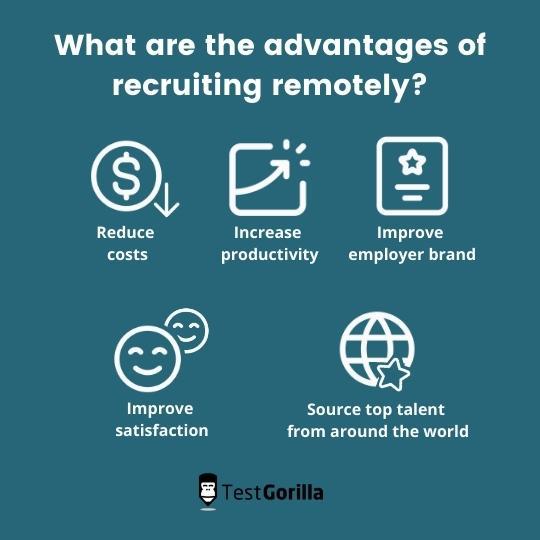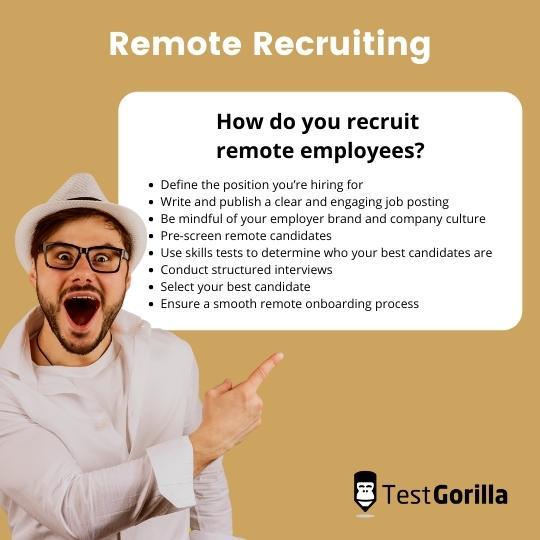Remote work is becoming more and more commonplace, which makes remote recruitment essential if you want to continue attracting and hiring top talent. While many companies have been fully remote for a while now, more and more companies are making the switch to fully remote teams since the beginning of the COVID-19 pandemic.
Table of contents
Among some of the companies that are 100% remote, you can find 10up, Buffer, Doist, FlexJobs, GitLab, Groove, InVision, Automattic, Zapier, and many others, including our own company, TestGorilla (our team is spread over five continents and 11 countries, and counting).
This article will look into the advantages of remote recruitment and outline our 8-step strategy for hiring top talent remotely.
What are the advantages of recruiting remotely?
Remote recruitment has several advantages for both businesses and workers. Let’s look into how remote hiring can help you.
Reduce costs for yourself and employees
Remote work allows companies to reduce their overhead costs in many ways. They no longer need to:
Rent or buy office space
Provide snacks and drinks
Use cleaning services
Employees also save money when working remotely. They don’t need to spend on:
Gas, car maintenance, or public transportation
Lunches at the office
Formal clothing (including dry cleaning)
Savings for remote workers can mount up to $4,000 per year, according to a survey by FlexJobs.
Besides the above, employees don’t need to spend time on a daily commute when working remotely.
By reducing overhead costs, you’re able to offer more competitive compensation and invest more into your employees’ well-being. For example, you could sponsor gym memberships or sports equipment for home, online courses (that aren’t work-related), or even monthly massages. A home office is usually cheaper to equip than renting office space, as well.
Increase employee productivity
Although monitoring productivity and efficiency in a remote setting is potentially more challenging for managers, a Stanford study by Nicholas Bloom et al. demonstrated that productivity increased by 13% for home workers compared to those working in an office.
Of course, not all sectors allow for remote work. Among those who do, finance, tech, IT, management, and professional services have the highest potential for distributed work with no loss in productivity.
Improve your employer brand
According to a 2020 survey by Growmotely, 74% of the surveyed professionals and entrepreneurs expect remote work to become the new normal. This means that remote recruitment, too, is here to stay.
By giving employees more freedom and flexibility, you’re showing them you trust them to do a good job at home, with minimal or no surveillance. This can help you build a company culture based on trust, collaboration, and openness.
Improve employee satisfaction
According to a McKinsey report, employee satisfaction increases with the possibility to work remotely at least some of the time, and most workers would prefer a hybrid or a fully remote working model after the pandemic is over.
Per the same report, if they were to return to full-time office work, many employees would change jobs—up to 30%. This means that if you’d like to retain your best employees, you need to be flexible, and to hire top talent, you need to invest in building a solid remote hiring process.
Source top talent from around the world
Remote recruitment allows you to tap into a global talent pool and not be limited to a specific area or even country. Of course, global hiring comes with its own obstacles and tax and legal challenges, but these costs can be offset by reducing overhead costs, for example. Still, some organizations might opt to hire in the country where they’re based to manage the legal complexity of remote work efficiently.
How do you recruit remote employees?
Let’s now look into the steps you need to take to hire top talent remotely.
1. Define the position you’re hiring for
Define the role you’re looking to fill by outlining the duties and responsibilities, as well as the required skills and qualifications. Besides that, you need to define what “remote” means for this position: is this a fully remote job or a partially remote (hybrid) role? What’s the level of flexibility you’d like to provide?
You also need to decide on the geographical scope: will you be hiring in your home country or globally? This has tax & legal implications for you and your new hires. If you’re hiring globally, you might decide to opt for a contractor who is working for you part-time instead of an employee. Define what your exact needs are.
2. Write and publish a clear and engaging job posting
Write a clear title and a job description that gives enough specific information on what you’re looking for. Avoid terms like “ninja,” “rockstar,” and the like, and set clear and realistic expectations for the role.
In a job ad for remote work, you need to include some important information, such as:
Whether you’re open to receiving contractor applications
The required time zone availability
The necessary equipment and whether you’ll be providing any (or whether you’re able to allocate a budget for home office equipment)
This way, candidates can instantly see whether they can be a good fit, and you won’t be wasting time reviewing applications if there’s time zone incompatibility, for example.
You can publish the job ad on websites for remote work specifically, as well as on LinkedIn, on your Careers page, and classic job boards, such as Monster and Indeed.
3. Be mindful of your employer brand and company culture
Remote applicants will likely research you online before applying, so you need to ensure your online presence gives the right impression.
Here are some of the things hiring managers should assess before you begin recruiting remotely:
Do you have a polished online presence?
Are your social media profiles up-to-date? Do you post frequently?
On social media, do you talk about your company culture, team-building events (even virtual ones), and the things that make your company a great place to work?
Does your employer brand inspire trust? What are your values, as an employer, that you’re communicating to the world?
Have you put your vision, mission, and value statement on your website?
Are you able to guarantee a positive candidate experience to all your applicants?
What are your employees saying about you?
Your employer brand is crucial for remote recruitment, as your applicants might never see your office or meet you in person. You could use our 8 questions to further assess your organizational culture.
4. Pre-screen remote candidates
Now comes the time to quickly pre-screen your remote candidates. Disqualify candidates who don’t meet your basic requirements, such as:
Applicants who don’t have the right skill set for the role
Applicants with no relevant experience or qualifications
Applicants who aren’t located in the geographic location where you’re hiring, unless you’re hiring globally
Applicants with whom you’d have a time zone incompatibility
Make sure you’re keeping disqualified candidates informed on the outcome of the pre-screening process to guarantee a smooth remote recruiting process and a positive candidate experience.
5. Use skills tests to determine who your best candidates are
You can now administer online skills assessments and personality tests to narrow down your selection of remote candidates. Skills assessments allow you to evaluate candidates’ skills and knowledge in a specific area, such as, for example, outside B2B sales, cybersecurity, or technical SEO.
To check for a culture fit or culture add and get a better understanding of your candidates’ strengths and weaknesses, you can use personality and culture tests. These aren’t meant to evaluate applicants but simply to better understand them and manage them more efficiently in the future (which is particularly important for both remote recruitment and remote work).
You can also use short asynchronous video interviews to get a feel of your candidates’ communication style and language skills.
Analyze results, compare candidates to see who stands out, and proceed only with a small selection to save the time and energy of your hiring team.
6. Conduct structured interviews
You can now proceed to interviewing your top candidates.
For remote recruiting, we advise you to use structured interviews, i.e., interviews in which you’re always asking the same questions in the same or similar order and during which you’re taking detailed notes. Structured interviews help you mitigate hiring biases and hire a diverse workforce.
If you have a hiring committee, make sure everyone from your hiring team is on the same page and understands what qualities the ideal candidate should possess.
7. Select your best candidate
Compare results, select your best candidate and make an offer to them. Reconfirm their availability and the level of flexibility your company allows.
Check their equipment to ensure they have all the tech they need to get started and plan to buy and have equipment shipped to them if necessary. Based on their location, you might want to allow at least a week for this, sometimes more.
8. Ensure a smooth remote onboarding process
If your new hire only works remotely, you need to be particularly mindful of your virtual onboarding process.
Onboarding starts with orientation and introducing the new employee to existing team members; for this, you could schedule a quick Zoom chat with their team, as well as weekly check-ins. Let them know who they should turn to if they have additional questions, and make sure you’re also available to help them out during onboarding.
Discuss all the onboarding details with the team manager and see what additional necessary training and how they’ll handle it exactly. Make sure the new employee knows what their first tasks are, the exact requirements, and what success at the role looks like. Check whether they have access to all the information, systems, and files to get started.
Remote recruitment helps companies source top talent globally but needs to be carefully managed
Remote recruitment is challenging, and if you’re a fully remote company, you need to be particularly mindful of a number of things such as:
Your employer brand and image
The legal and tax implications of remote work
Your company culture
Team engagement in a distributed environment
Cultural, similarity and other unconscious biases
Remote hiring allows you to be exposed to a global talent pool, reduce overhead costs, improve employee satisfaction and retention, and build a strong company culture based on trust and openness.
Related posts
Hire the best candidates with TestGorilla
Create pre-employment assessments in minutes to screen candidates, save time, and hire the best talent.
Latest posts
The best advice in pre-employment testing, in your inbox.
No spam. Unsubscribe at any time.

Hire the best. No bias. No stress.
Our screening tests identify the best candidates and make your hiring decisions faster, easier, and bias-free.
Free resources
This checklist covers key features you should look for when choosing a skills testing platform
This resource will help you develop an onboarding checklist for new hires.
How to assess your candidates' attention to detail.
Learn how to get human resources certified through HRCI or SHRM.
Learn how you can improve the level of talent at your company.
Learn how CapitalT reduced hiring bias with online skills assessments.
Learn how to make the resume process more efficient and more effective.
Improve your hiring strategy with these 7 critical recruitment metrics.
Learn how Sukhi decreased time spent reviewing resumes by 83%!
Hire more efficiently with these hacks that 99% of recruiters aren't using.
Make a business case for diversity and inclusion initiatives with this data.





















